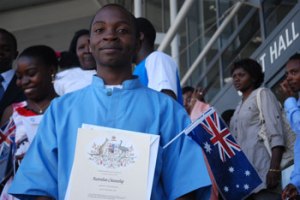Posted 22/06/2011 by Harriet Spinks

A recent study, commissioned by the Department of Immigration and Citizenship and conducted by Professor Graeme Hugo of the University of Adelaide, has examined the contributions made to Australia by first and second generation humanitarian entrants. The report of the study,
Economic, social and civic contributions of first and second generation humanitarian entrants, found that while refugees and other humanitarian entrants face numerous barriers to settlement in Australia, they nonetheless contribute positively to society in a number of different ways.
In the context of Australia’s population profile, humanitarian entrants deliver what is termed in the report as a ‘demographic dividend’ by contributing favourably to Australia’s age structure. Humanitarian entrants have the youngest age structure of all migrants groups and the largest proportion of dependent-age children. They are also more likely than other migrant groups to remain in Australia—spending their entire lives and raising their families. This helps to counteract the effects of an ageing Australian population, by adding to the supply of working age people—for many refugees, virtually their entire working lives will be spent in Australia. Further, humanitarian entrants have begun to contribute to the revival of regional populations and economies, as they are increasingly settling in regional Australia.
Previous studies have highlighted the initial difficulties faced by newly-arrived refugees and humanitarian entrants in terms of workforce participation and employment. This report confirms that humanitarian entrants face numerous barriers to employment. These include: mental and physical health problems due to pre-migration experiences; limited and disrupted education; lack of knowledge about the Australian labour market; lack of established networks, and racism and discrimination on the part of potential employers. Given these difficulties, it is perhaps not surprising that humanitarian entrants initially experience higher levels of unemployment than other migrants.
However, Professor Hugo’s study looks beyond the initial settlement period, to show that as time passes, the workforce participation rate for humanitarian entrants converges towards the Australian average. Significantly, there is a marked increase in participation rates and a decrease in unemployment rates for second-generation humanitarian entrants. The report’s analysis of data by country of birth found that for second-generation humanitarian arrivals, at least half of the nationality groups have a higher level of participation than the Australian born population. Ten nationality groups have unemployment levels below that of the Australian born.
The report also found that humanitarian entrants contribute to Australia in economic terms beyond labour force participation. In particular, humanitarian entrants are highly entrepreneurial, with a higher than average proportion engaging in small and medium business enterprises. In addition, humanitarian entrants often fill important labour shortages in the economy by working in low skill, low paid positions, which are difficult to fill from the Australian born labour force. Finally, humanitarian entrants contribute towards economic links between Australia and other countries via the remittances they send home. Not only do such remittances have an important developmental effect in the receiving country, but Hugo’s study suggests that these economic linkages may have positive impacts on bilateral trade between Australia and countries of origin.
Hugo’s report also examined the broader social and community contributions made by humanitarian entrants to Australia. It concluded that humanitarian entrants build social capital in a number of ways. For example, humanitarian entrants provide critical support networks for new arrivals, and engage in volunteer work to a significant degree. For second-generation entrants, levels of volunteering were on par with the Australian born population. The report also indicates that humanitarian entrants feel well-connected to their local communities, often to a greater degree than other migrant groups, and this sense of engagement increases over time. Further, humanitarian entrants have made significant contributions across a range of fields in Australia, including business, community leadership, sport, the arts and science.
Professor Hugo’s study confirms that the initial settlement period for refugees and other humanitarian entrants is often difficult, and that it is characterised by high levels of government support and low levels of workforce participation. However, the study also shows that over time, as initial challenges are overcome, there is a strong trend towards high levels of economic and social participation by these groups—this is particularly true for the second generation. While it should not be forgotten that some humanitarian entrants continue to struggle beyond the initial settlement years, the overwhelming conclusion of Hugo’s analysis is that refugees and humanitarian entrants make a significant and distinctive contribution to the Australian economy and community.
Image source: Department of Immigration and Citizenship web site http://www.immi.gov.au/media/success_stories/dream-come-true.htm